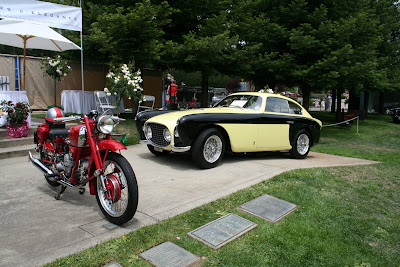Our hotel that night was near the Ginza, so we took the Shinkansen back to Tokyo Station. There we met Uncle Keisuke, my father's older brother, and they talked some family business. I am not exactly clear on all the family business, but my father's mood seemed different after that meeting. In Kumamoto, he was very upbeat and easy; after he seemed more circumspect. We had some coffee and tea, and said our good byes, and stepped into the Tokyo lights to find dinner.
Saturday broke cool and sunny. Donna and I got up early to gather breakfast and walk around the Tsukiji area. Donna first wanted to stop at the Buddhist shrine near the Tsukiji station. As we wandered, we came upon a few old houses mixed with the office buildings and shops. These were old, copper-clad structures with a heavy patina; outside the house, were live chickens in tidy pens sitting right on the street. The shrine itself had a striking "Indian" versus Japanese (or even Asian) feel, and it piqued our curiosity. Inside the smell of the incense was sharp and strong.
Tsukiji is the famous raw fish market, and though Donna is not a fan of sushi, the markets just behind the trading hall were a fascinating collage of the strangest food textures, colors, and scents. Cuttlefish, flattened and dried were sold in little bundles. Small crabs were tied in into fist-sized packs with colorful twine. Bright, tangerine-red octopus tentacles were laid out with the sucker-sides up. Others vendors offered grilled yaki-tori, odd-looking root vegetables, and beautifully wrapped fruit.
We spent the rest of the morning walking around the Ginza, shopping. Donna wanted to find a good stationery store, and as we stood outside the Mitsukoshi, waiting for the stores to open, a remarkably friendly and helpful Japanese woman over-heard us and volunteered to walked us to the Ito-Ya shop just down the street. This stretch of the Ginza also included the Ginza Apple Store, Tiffany's, and the Ginza Matsuya. Before heading to Narita, we decided to get our bentos in Mitsukoshi's food basement, where we would have a better, albeit more expensive, selection. Donna was happy to find a salad bar and "real bread".
It was amazing to watch the queues in Mitsukoshi, too - there was some kind of Vermont Teddy Bear event on the main level, and the lines curled around, between, and under the escalators. There was even a queue in the bread shop for folks who wanted their loaves sliced. As I waited for Donna to buy a small baguette, people pushed past me to get in line, until I realize what was going on. They seemed to be in such a hurry to get in that line. And on the way out, with all our shopping bundles, an another decided to make me a lead blocker: she put her hand on my side and pushed me into and through the crowd of teddy-bear fans. As I turned to see who was pushing, I could not have been more surprised to find an old, tiny woman in formal kimono. I guess I was in her way.
It seemed a shame to leave on such a beautiful day, but we made our way back to the hotel. On the way, Donna was stopped by an Australian couple needing English directions to Tsukiji. We pointed them in the right direction, but Donna reminded me that if we were Japanese, we would have walked them down there ourselves. We got to the hotel, gathered our luggage, and called a cab to take us to - the train station. And by now it felt like we were pulling the weight of the trip with us. We were tired of waiting, tired of trains, and just plain tired.
We ate our bento lunches on the Narita Express, and arrived at the airport in short order. Security in Japan was another odd exercise in mistaken practice - shoes do not need to be removed, but apparently, tiny, blunt-tipped, yarn scissors do.
EPILOGUE
I took this trip, of course, to spend time with my folks, and to search with them for a sense of their place, their past, and their home. I realize now that if I had grown up in a place with 400-year old castles, ancient festivals, and ceramists with a fourteen generations-long legacy, I might feel different about the places where I spent my childhood.
I grew up in suburbia, that generic sprawl that's anywhere and nowhere at the same time, but the myths of my boyhood were things like westerns. My father appears to have grown up on the set of his own samurai movie. He looked out on the island where Musashi dueled with Kojiro, he walked in castles and shrines visited by the shoguns and damiyo, and on New Years Day he visited the Imperial Palace and caught a glimpse of the Emperor.
Though I feel closer to the stories, I am still in the audience. More than nostalgia, I think my father's boyhood was grounded by this culture, and the myths were tangible. Japan has found a way to keep that alive; like raising chickens on the streets of Tokyo or saluting a train as it leaves the station, these things continue. I could never go home the way he did, because I don't have a place like that. I'm thankful I got to go home with him.
























